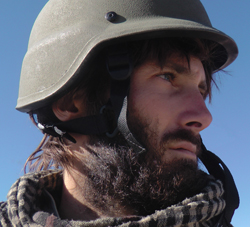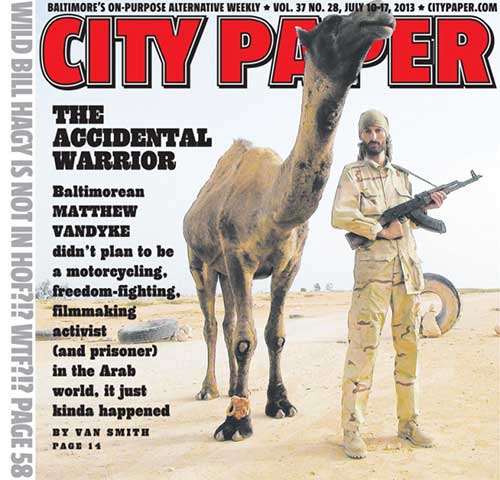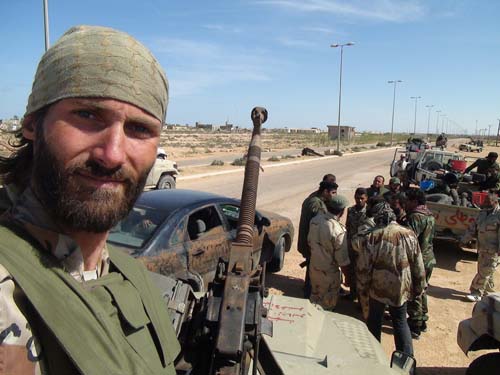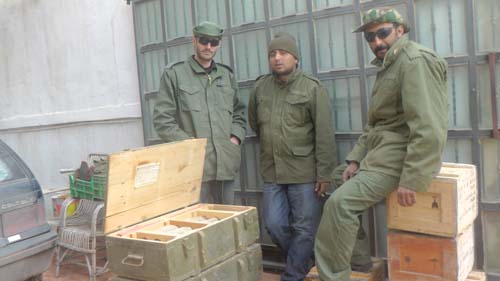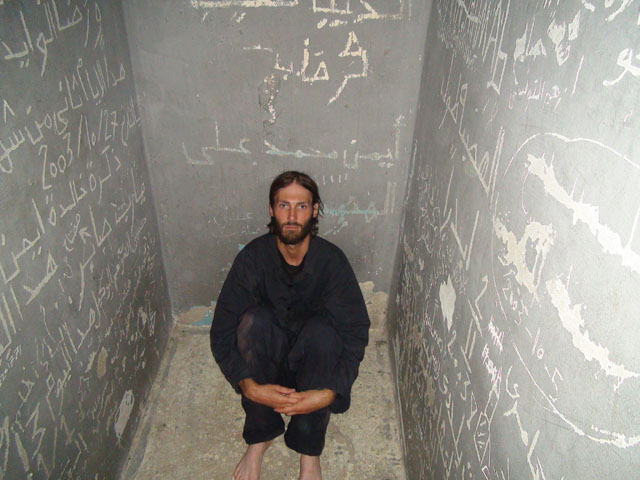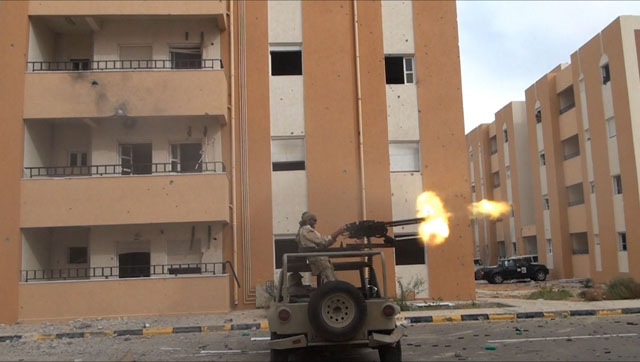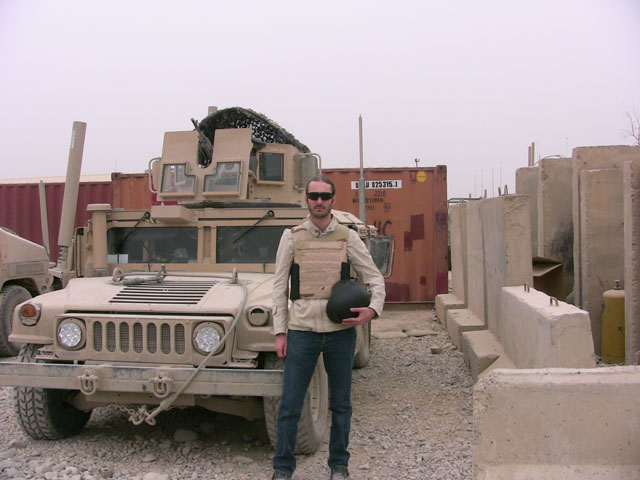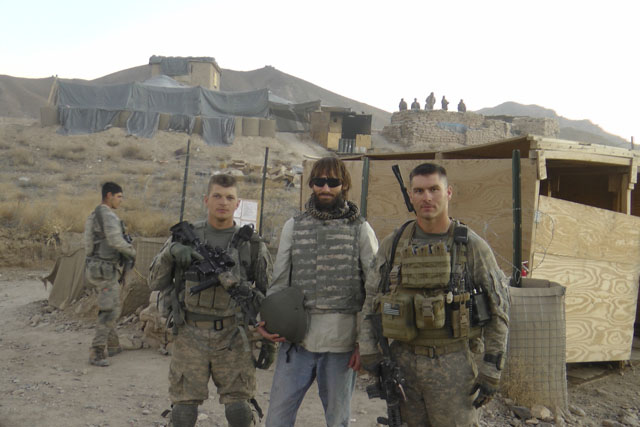About Matthew VanDyke
For the latest information about VanDyke, his work in Syria, his films, and public speaking appearances, or to leave a comment for Matthew VanDyke, "Like" the Matthew VanDyke Facebook Page
-
Sons of Liberty International (SOLI) (2014-present)
-
Syria (2012-2014)
-
Combatant and Prisoner of War (POW) in the Libyan Civil War (2011)
-
The Motorcycle Adventure Years (2007-2010)
-
War Correspondent Embedded with the US Military in Iraq (2009), Afghanistan (2010)
-
Background
Sons of Liberty International (SOLI)
In 2014, Matthew VanDyke's friends James Foley and Steven Sotloff were executed by ISIS. In response, VanDyke founded Sons of Liberty International (SOLI), the first military contracting firm run on non-profit principles. SOLI provides free military advising and training to communities threatened by insurgency and terrorism.
SOLI relies entirely on financial contributions from the public to make this possible.
SOLI's current mission is training Iraqi Christians to fight against ISIS.
To learn more about SOLI, visit the website at:
www.SonsOfLibertyInternational.com
Syria
Information about Matthew VanDyke's award-winning documentary film about the war in Syria, Not Anymore: A Story of Revolution, can be found at the film's website:
VanDyke has made the film available for free to the public through YouTube.
Click here to watch Not Anymore: A Story of Revolution
More information about VanDyke's work in Syria:
Among the best articles yet written about Matthew VanDyke appeared in Baltimore City Paper on July 10, 2013. It was the cover story and an in-depth feature about VanDyke, his fighting in the Libyan revolution, working for the Syrian revolution, and his plans for the future. Click on the image below to read it:
A must-read article at Vice, The American Filmmaker Who Became a Freedom Fighter in Libya
An in-depth feature article and cover story about Matthew VanDyke appeared in Das Magazin (part of Tages-Anzeiger newspaper in Switzerland) on 2/23/13. Written by Fritz Schaap, who spent a few days with VanDyke in the USA, it is an in-depth article about why VanDyke does what he does, why he fought in Libya, and his current work in Syria.
The original article with photos (in German)
English translation of article
Freedom Fighter and Prisoner of War (POW) in
the Libyan Civil War (the Libyan Revolution)
When the Libyan Civil War began in February, 2011, Matthew VanDyke contacted some of his friends in Libya he knew from previous travel there in 2008. They told him about family and friends being arrested, injured, and killed. They told him about taking to the streets in defiance of Muammar Gaddafi, and the likelihood that they would soon lose their lives. One of them asked VanDyke if he would tell people about him if he was killed by the regime. They told of fighting against Gaddafi's guns with just rocks.
They asked why nobody was helping them.
VanDyke had heard enough. His friends and their families were suffering and he had to help. VanDyke told his mother, Sharon VanDyke, that he was going to help his friends and the revolution. Although he did not tell her his intention to fight as an armed combatant, he did make it clear that the mission was personal and that he would not be working as a journalist in Libya. She was supportive of his decision and drove him to the airport.
On February 26 he left the United States and flew to Cairo, and arrived in Benghazi, Libya on March 6. He met with his Libyan friend Nouri Fonas, whom he had met in Mauritania in 2007. The last time VanDyke saw him in 2008, Nouri was a traveling hippie.
Now he had become a warrior.
VanDyke joined Nouri and a group of rebels who were preparing to fight against Gaddafi. He began working for the cause on the first day, helping to repair and camouflage the Toyota Hilux pickup truck that had been damaged in the Rajma weapons facility bombing, and which they would be using in the war. They mounted a Russian DShk (Dushka) heavy machine gun on a turret welded into the back of the truck. They gathered ammunition from the bunkers at Rajma for the DShK, their RPG, and additional ammo for the rebel army forming in Benghazi.
There were not many rebels. At the time it looked as if NATO and the international community would not intervene to help the uprising against Muammar Gaddafi. Many Libyans were still sitting in their homes or in cafes in the east of the country, afraid to take up arms for a lost cause, knowing that when Gaddafi captured Benghazi they and their families would be executed or sent to prison for years.
It was a very desperate situation. Gaddafi's army was large and well-equipped. Most rebels only had AK-47s, RPGs, and DShk machine guns in pickup trucks. Some even went to the front line without any weapon at all.
VanDyke called his mother and told her everything he was doing in Libya. He told her about preparing the vehicles, acquiring weapons and ammunition, wearing a Libyan military uniform that allowed him to move as an undercover Libyan and gain access to military bases without difficulty, and various other work he was doing for the revolution. He told her that he and Nouri, along with the other rebels in their group, would be advancing west with the rebel army and working as support troops. This was partly true - they would be doing that work, but would also be fighting on the front lines as part of the main force, and VanDyke would be a DShk machine gunner. He did not tell his mother this because he did not want her to worry.
On March 12, VanDyke went with three rebels on a reconnaissance mission to Brega. Ra's Lanuf had just fallen to Gaddafi's forces, and Brega would be next. The plan was to recon the city, identify defensive positions, and then return to Benghazi to gather more men and weapons before going back to Brega to mount an organized defense. Nouri remained in Benghazi, continuing his work on an army base helping to prepare vehicles for combat.
On March 13, during the reconnaissance, they were ambushed by Gaddafi's forces. VanDyke was struck in the head during the ambush and woke up in a prison cell to the sound of a man being tortured in a room above him. He has no memory of the ambush or what happened to the men he was with.
He was interrogated in Sirte and then handcuffed, blindfolded, and transported by airplane to Tripoli. He was imprisoned in Libya's "nightmare factory," the Maktab al-Nasser prison, in a 4 x 7 foot cell for the first 85 days. He was then transferred to Libya's most notorious prison, Abu Salim, where Gaddafi had massacred 1,500 prisoners in 1996. During his entire 5.5 month imprisonment VanDyke was held in solitary confinement and underwent severe psychological torture.
The Gaddafi regime denied for months that they had VanDyke in custody, but Sharon VanDyke never gave up hope that her missing son was alive. She began a media campaign for his release. She wrote a biographical document about Matthew VanDyke that she gave to organizations that approached her willing to advocate for his release. This document clearly stated that Matthew VanDyke was in Libya working for the revolution, and specifically noted that he was helping to prepare Libyans for combat and not working as a journalist. Despite knowing he was not working as a journalist in Libya, some individuals and organizations made the decision to advocate for VanDyke. Unfortunately, a reporter labelled VanDyke a journalist in an article and that label was repeated in subsequent articles by media covering his disappearance, despite efforts by Sharon VanDyke and Matthew's girlfriend to correct them and make it clear that he was not working as a journalist in Libya.
Eventually the Gaddafi regime, under growing pressure, admitted that VanDyke was in custody, but refused to tell where he was or grant anyone access to him. The US government was never able to locate VanDyke. It was Nouri Fonas' contacts in Tripoli who discovered that VanDyke was being held in Abu Salim Prison.
On August 24 the prison guards fled Abu Salim prison as the rebel forces began to capture more territory in Tripoli. Before fleeing they released a few of the prisoners, who then released more prisoners. The prisoners broke the lock off VanDyke's cell and he escaped with them, running for their lives.
VanDyke waited in Tripoli for Nouri to arrive. During this time he gave interviews to the media. He was shocked and disturbed to learn that some media had reported that he was working as a journalist in Libya when captured. VanDyke devoted a considerable amount of time and effort while in Tripoli to do everything he could to make it clear to the press that he was not working as a journalist when captured, and that he should never be referred to as a journalist in their articles. He told them he was in Libya for "personal reasons," and that he came to "help his friends," without giving details.
The press were confused about why VanDyke was not returning home after spending nearly six months in prison and enduring so much physical and psychological hardship. VanDyke's mother, however, understood. Knowing that VanDyke was working as a rebel when captured, she knew he wasn't going to come home. She had raised him to keep his commitments, and he had made a commitment to the cause of freedom and to the men he was captured with. He had told those men he would not leave Libya until Libya was free. He also wasn't going to return to the United States and leave those men behind, or any prisoners of war behind. He vowed he would not leave the country until Libya was free, and until all cities were liberated from Gaddafi forces and all POWs were released from the prisons.
When Nouri Fonas arrived in Tripoli, he and VanDyke soon left for Benghazi. They spent one night in Benghazi and then rode with some rebels to Ra's Lanuf. VanDyke met with the commander of the Ali Hassan al-Jaber Brigade, Mohammed Akfayer, and asked to join his unit. Akfayer agreed and VanDyke enlisted in the National Liberation Army of Libya. Commander Akfayer assigned a KADBB Desert Iris military jeep to VanDyke and Fonas, which they later mounted a DShk heavy machine gun on. VanDyke became a DShk machine gunner, and Fonas was the driver.
VanDyke and Fonas were some of the first rebels into the town of Harawa the day it was captured, and took rocket fire from the enemy. This was the first of 40 engagements they would have with the enemy. VanDyke and Fonas took part in a lot of combat on the front lines during the Battle of Sirte, both with the DShk and as infantrymen, including in urban warfare and house to house fighting. When not in combat they worked closely with the international press covering the war, providing them with information to help them report accurately on the war, and taking journalists with them in the jeep to the front lines.
VanDyke was in Sirte the day Muammar Gaddafi was killed. With the war over, he and Fonas traveled to Tripoli for the celebrations, and VanDyke was able to meet with some of the friends for whom he had come to fight.
Matthew VanDyke was awarded a Shield of Courage Award for his military service by Commander Mohammed Akfayer of the Ali Hassan al-Jaber Brigade, and an Embassy of Libya Award for Support, Commitment, and Outstanding Dedication for his contributions to the revolution.
VanDyke has extensive film footage of his work as a rebel before being captured in March 2011, and of his experiences as a soldier in the National Liberation Army of Libya after his escape from prison.
He is currently writing a book and producing a documentary film about his experiences in Libya.
More photos of Matthew VanDyke in the Libyan Civil War can be seen here
Matthew VanDyke also writes The Freedom Fighter Blog, which contains personal accounts of his ongoing mission to combat authoritarianism, and analysis and commentary of current events surrounding the struggle for freedom worldwide.
Motorcycle Adventures (2007-2010)
Solo Motorcycle Journey Across the Arab World
After earning his Master's Degree in Security Studies from the Edmund A. Walsh School of Foreign Service at Georgetown University, Matthew VanDyke wanted to see the Arab world. Inspired by the adventure documentary films of Australian filmmaker Alby Mangels, he set off for Africa and the Middle East on a Kawasaki KLR650 motorcycle in 2007. His adventures lasted three years and took him across North Africa and the Middle East, to Morocco, Mauritania, Tunisia, Libya, Egypt, Jordan, Syria, Turkey, and finally to the battlefields of Iraq. Some of his most dramatic adventures included:
- Morocco - VanDyke suffered a serious motorcycle accident and broke his collarbone in the infamous Rif Mountains.
- Mauritania - His Kawasaki KLR650 had a burned out motorcycle clutch while on a deep desert safari in the Sahara and he had to hide it in the desert for days until he could negotiate with a villager to transport it back to Nouakchott in the back of a truck, with a goat. After his return to Nouakchott VanDyke met Mohamed Haidara, a Scottish paratrooper turned camel shepherd, and Nouri Fonas, a Libyan who was traveling the world. They all became good friends, and in 2011 Fonas and VanDyke served and fought together in the Libyan Civil War. In late 2007, in need of money, VanDyke became a car smuggler in West Africa, transporting used Mercedes from Morocco to Mauritania. After having two cars stolen and lacking the money to continue the smuggler's life, he resumed his motorcycle journey.
- Tunisia - Facing difficulties obtaining a visa for Algeria, VanDyke was forced to take Mediterranean ferries to get to Tunisia. He made attempts to sneak across the Tunisia-Algeria border but was repeatedly caught by Tunisian authorities. VanDyke also narrowly avoided serious injury in Tunisia when his gas stove leaked and burst into flames while he was cooking.
- Libya - VanDyke was the only American in history to cross Libya by motorcycle while Muammar Gaddafi was in power. VanDyke paid a bribe to obtain a visa for travel in Libya at a time when Americans were unable to obtain visas. After six weeks in Libya, during which time he filmed the local motorcycle scene, he was expelled from Libya by the Gaddafi regime under suspicion of filming things they didn't want filmed. He was given 48 hours to leave the country and drove over 1,500 kilometers from Tripoli to Tobruk in one day. It was during his time in Libya in 2008 that VanDyke made the friendships that would later compel him to return to Libya in 2011 to fight in the Libyan Civil War.
- Egypt - He toured Egypt by motorcycle in 2008 and 2009. While in Egypt he was hit by 3 vehicles, one of them being a police truck. In 2009 he drove the 1,200 kilometers from Aswan to Nuweiba virtually non-stop, a motorcycle journey that took over 24 hours due to mandatory police escorts in the Nile River Valley and checkpoints.
- Jordan - VanDyke became friends with members of the Jordanian Royal Family, toured the desert with two Portugese motorcyclists, and learned the hard way to never get the salty water of the Dead Sea in your eyes.
- Syria - During VanDyke's 3 trips to Syria he explored the dangerous Syria-Iraq border region and had his motorcycle stolen in the city of Hama. It was recovered when Syrians surrounded the thieves within minutes of the motorcycle theft.
- Turkey - He was briefly and humorously trapped in a gateway at the Syria-Turkey border when the Syrians allowed him to leave the country after the Turks had already closed their side, and was prepared to spend the night in the no-man's land until the Turks acquiesced and grudgingly allowed him into the country.
- Iraq - VanDyke was the first American to enter Iraq by motorcycle. He was the first foreign motorcyclist to travel to the city of Kirkuk and the Salahaddin and Diyala Provinces in Iraq, and attempted to drive to Baghdad by motorcycle a few times but was arrested by Iraqi security forces. VanDyke was arrested or detained 20 times by the Iraqi security forces between 2008 and 2010. Some of the arrests ended badly, but others gave him the opportunity to befriend those who arrested him, giving him valuable contacts in the country. In need of money he took a job teaching English to graduate students at the University of Kurdistan-Hawler, and later worked as a war correspondent embedded with the United States Army and Marines.
Matthew VanDyke suffers from Obsessive Compulsive Disorder (OCD), which makes his adventures especially difficult at times. His OCD manifests itself primarily as heightened fears related to driving, avoiding trash, and obsessions about cleanliness.
More than a dozen companies have sponsored VanDyke's motorcycle adventure filmmaking by providing products and services.
Nearly everything described above was captured on film.
Some of the footage will be included in VanDyke's film about his experiences in Libya (currently in production).
More photos of Matthew VanDyke's Motorcycle Adventures in the Arab World can be seen here
Warzone Bikers
In June 2010 Matthew VanDyke and photographer Daniel Britt, who met in 2009 while working as embedded journalists with the US Military in Iraq, drove motorcycles from Iraq to Afghanistan, by way of Iran. The project was a documentary film about their travels from Baghdad, Iraq to Bagram, Afghanistan by motorcycle to take an embed journalist assignment with the US Army in Afghanistan.
Iraq - VanDyke purchased two used MZ Kanuni 250cc motorcycles and used his connections in Iraq to have the motorbikes registered with Iraqi license plates to allow them to cross borders. VanDyke and Britt strapped on their bodyarmor and attempted to drive to Baghdad by motorcycle in August 2010. They were arrested by Iraqi police a few hours into their journey and interrogated near Baquba. They were then transferred to the custody of a unit near Baghdad, where they were hooded, beaten in the head, handcuffed, and accused of being Al Qaeda terrorists. They were interrogated again in Baghdad and made to face a wall in a Baghdad prison while an Iraqi with an AK-47 stood behind them. They believed they would be shot, and this incident appears to have been a "mock execution," a form of psychological torture. They were placed in a cell with other inmates and the US State Department was unable to locate them for two days. The second night they slept in a military barracks. The State Department eventually located VanDyke and Britt and secured their release. The incident was reported by the Iranian Fars News Agency as the arrest of two "Jewish Americans running espionage operations." VanDyke and Britt are not Jewish, were not conducting espionage, and are not spies. After Fars News Agency issued this report the State Department contacted VanDyke and Britt and advised them to leave Iraq as soon as possible. They left a few weeks later according to their schedule, after their Iraq filming was complete.
Iran - After the Fars News Agency article the Warzone Bikers project became especially dangerous. VanDyke and Britt knew that they could be detained after crossing the border and held in prison like the 3 hikers who had been captured a year earlier. They decided to continue, but left their bodyarmor and covert camera equipment behind in Iraq.
VanDyke and Britt were fortunately not arrested or questioned about what happened in Iraq. Although they were not harassed by Iranian authorities, they did face many difficulties due to problems with Britt's motorcycle, and VanDyke crashed his motorcycle on an oil slick on the road in Mashhad. He suffered no injuries and only minor damage to the motorcycle which was easily repaired.
Afghanistan - In addition to persistent problems with Britt's motorcycle, the two had to also avoid being kidnapped soon after arriving in Afghanistan. An Afghan friend told them of overhearing talk of a kidnap plot against them, and another Afghan friend later revealed that he received a phone call from a man wanting to kidnap them for ransom. VanDyke and Britt began dressing as Afghans to blend in, and carried sawed-off shotguns concealed beneath their clothing.
They quickly realized that due to the number of checkpoints and their difficulties in Iraq that travel between Herat and Kabul by motorcycle would be impossible due to the Afghan security forces. They transported the motorcycles on a cargo bus and dressed undercover as Afghan passengers on another bus with their concealed sawed-off shotguns beneath their clothing. During the journey on the IED crater scarred road from Herat to Kandahar to Kabul, VanDyke and Britt witnessed combat outside the bus window as they passed.
While in Kabul they became friends with members of a secret Afghan cult. VanDyke and Britt are the only non-Afghans to have ever witnessed the rituals and practices of the cult.
After some time in Kabul they drove to Jalalabad, where VanDyke stole a brick from Osama bin Laden's former house (which was bombed by the United States Airforce in 2001). VanDyke then planted an American flag in the ruins before they escaped from the dangerous neighborhood on their motorcycles. From Jalalabad they drove to Charikar and onward towards the destroyed Buddha Statues of Bamiyan, but Britt's motorcycle broke down on the way and so they camped behind a rockpile on the side of the road. During the night they were pursued by armed bandits searching for them, and narrowly escaped being captured.
The next morning VanDyke and Britt's motorcycles were discovered by plain-clothes Afghan police, who fired a warning shot, charged their position, and arrested them. They were later transferred to the custody of an American Military Police unit in Charikar. VanDyke and Britt were well-received by the US Army personnel at the base, and were allowed to spend nights at the base from then on whenever they passed through Charikar.
The arrests continued. In the village of Rokha in the Panjshir Valley they were attacked by a village mob and accused of being members of Al Qaeda. During this incident VanDyke was punched in the face by an Afghan police officer, who then drew his weapon and arrested them both. VanDyke had a camera around his neck that recorded the entire incident. In Pol-e-khomri the two were detained by the security forces, and were questioned by security forces in Mazar-e-sharif. VanDyke was later arrested in Mazar-e-sharif in a separate incident, but was released from custody after a couple of hours.
The two reached the city of Bagram in November 2010, successfully completing the motorcycle portion of the Warzone Bikers, Baghdad to Bagram project. However, they were arrested by Afghan police upon their arrival in Bagram, and were later transferred to the custody of the US military at Bagram Airbase.
In December 2010 VanDyke and Britt began their embed assignments with the US Army and were well-received by the soldiers who were supportive of the Warzone Bikers project that had brought them there. VanDyke has remained in contact with some of the soldiers from the unit he embedded with at FOB Baylough.
Nearly everything described above was captured on film.
Some of the footage will be included in VanDyke's film about his experiences in Libya (currently in production).
More photos of Matthew VanDyke's Warzone Bikers Motorcycle Adventures in Iraq, Iran, and Afghanistan can be seen here
War Correspondent in Iraq and Afghanistan
In January and February 2009 Matthew VanDyke worked as a war correspondent for The Baltimore Examiner newspaper, embedded with the US military in Iraq. His embed experiences included the following:
Arab Jabour, Baghdad (COP Meade) - US Army 2nd Brigade Combat Team, 1st Armored Division 4th Battalion, 27th Field Artillery Regiment "Iron Thunder"
Arab Jabour, Baghdad (COP Dolby) - US Army 2nd Brigade Combat Team, 1st Cavalry Division "Blackjack"
Khalis, Iraq (COP Blackfoot) - US Army Alpha Company, 1st Battalion, 24th Infantry Regiment, 1st Stryker
Brigade Combat Team, 25th Infantry Division
Mosul, Iraq (FOB Marez) - US Army 1st Cavalry Division, 3rd Brigade, 3/8 Cavalry Battalion, Delta Company "Dragoons"Fallujah, Iraq (Camp Baharia) - US Marines
In November and December 2010 Matthew VanDyke filmed the US military in Afghanistan as part of the Warzone Bikers project. He embedded with the same unit the entire time, at the famous FOB Baylough:
Deh Chopan District, Zabul Province (FOB Baylough) - 3rd Platoon, Eagle Company, 2/2 CR
More photos of former journalist Matthew VanDyke in Iraq and Afghanistan can be seen here
Background
Family
Matthew VanDyke was born in Baltimore, Maryland, USA in 1981. He was raised by his mother, Sharon VanDyke, and his grandparents. He was the fourth generation to live in his family's house in South Baltimore. Sharon VanDyke was an elementary school principal; she retired in 2010.
Matthew VanDyke met his girlfriend who is in Point and Shoot, Lauren Fischer, during his first attempt at overseas motorcycle travel in 2006. He had shipped a 1981 Yamaha XS650 to Madrid, Spain to begin his journey to Africa and the Middle East, but the motorcycle had not yet arrived. While waiting at a Hostel in Madrid he met Lauren Fischer, who was in Spain to teach English. Fischer moved into an apartment and VanDyke moved in with her.
His motorcycle arrived, but due to its age had a series of mechanical problems that required VanDyke to remain in Madrid. VanDyke decided to remain in Madrid and pursue his relationship with Fischer. They remained together throughout his adventures overseas, during his time in Libya, and afterwards until 2014..
Education
Matthew VanDyke graduated summa cum laude from the University of Maryland, Baltimore County with a bachelor's degree in Political Science and a 4.0 GPA. He was the recipient of the Outstanding Scholar-Leader Award of the Political Science Department, a member of five honor societies, and represented UMBC at all three military academy student conferences. He is also a member of Mensa.
VanDyke graduated from the Edmund A. Walsh School of Foreign Service at Georgetown University in 2004 with a master's degree in Security Studies, with a regional concentration in the Middle East. His master's thesis examined the reasons why Al Qaeda targets the United States. VanDyke was one of the youngest students ever accepted into the Georgetown University Security Studies Program, having been accepted at the age of 22 (the average age being 27).
More information about Matthew VanDyke's academic background and accomplishments can be found in his LinkedIn Profile here:
Work
Matthew VanDyke has worked as a documentary filmmaker, journalist, war correspondent, political columnist, talk radio show host, English teacher, international businessman, and soldier.
He is currently working on a documentary film about his time in Libya, blogging for The Huffington Post and The Freedom Fighter Blog, appearing on radio and television as an analyst and commentator, and doing various projects to assist the struggle for freedom.
More information about Matthew VanDyke's work history and experience can be found in his LinkedIn Profile here:
